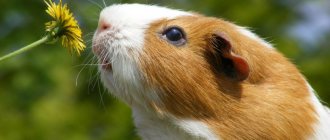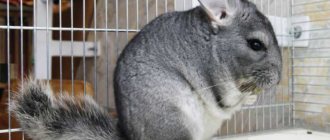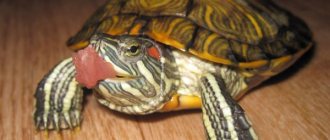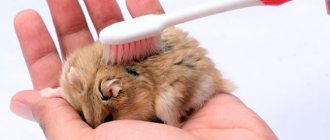Origin of Djungarian hamsters
The first mention of the Djungarian breed of hamsters appeared in the works of the German scientist P.S. Pallas in 1773. This researcher described the characteristics of the animal. In the middle of the 19th century. The first successful attempts were made to domesticate these representatives of the fauna. At the beginning of the 20th century. In Europe, keeping rodents at home has become popular, which has contributed to an increase in the population of these animals.
All hamsters currently bred in captivity are descended from a small number of wild-caught individuals.
This contributed to the emergence of mutations, incl. causing coat colors uncharacteristic for the breed. Subsequently, through breeding work, new colors were fixed at the genetic level.
Description of the breed
Djungarian hamsters are small, furry animals with a pointed muzzle and small ears. These creatures are active and inquisitive. Many people try to change their coat color, believing that such animals have better health. However, there are breeders who prefer pets of exotic colors.
Habitat
The homeland of Djungarian hamsters is the wormwood, xerophytic, gravelly-cinquefoil, and cereal-desert zones of North-Eastern Kazakhstan, Khakassia, and Western Siberia. Representatives of the breed also live in Altai. They can rarely be found in the steppe zones of the USA and Canada, but in these regions the wild population originated from pets brought from Europe, which people released into the natural environment.
Wild hamsters living in steppes and deserts are forced to obtain their own food, so their diet includes many types of food.
Rodents try to stay away from people, but when there is a lack of food in their natural environment, they raid agricultural land.
Coat color and length
Under natural conditions, the color of an animal's coat changes throughout the year. In spring and early summer, the fur on the back of the rodent is dark gray. At the same time, the abdomen remains beige. As the vegetation dies by the beginning of autumn, the fur acquires a pearl color.
In winter, the fur on the back becomes grey-white. This breed is characterized by a stripe of dark fur running along the spine and extending to the head. Changing colors helps animals protect themselves from predators. The length of the coat does not exceed 1 cm. There is a dense undercoat that protects the rodent from the cold. When kept at home, the color of the pet's fur does not change.
Color options for Djungarian hamsters.
Length and weight
Djungarians are small rodents whose body length is on average 7-15 cm. However, in the population there are smaller individuals that grow to 5-6 cm by the time of puberty.
The animal does not weigh the same throughout the year. In winter, it quickly loses weight, and in spring and summer it gains fat, even if the rodent lives in captivity and receives a sufficient amount of food every day. The weight of females is 19-36 g, and males - 19-45 g.
Character and lifestyle
In their natural environment, hamsters are nocturnal to avoid predators. Rodents dig holes or occupy others, often making nests in rock crevices. The animals spend most of the day in their shelter. Representatives of the species make provisions for the cold season.
Domesticated animals have largely retained the habits of their wild relatives. They are most active at night and can carry food into their house to stock up in case of a hungry period. These animals fiercely defend their territory. The fights between them are fierce.
The rodent is distinguished by its friendliness towards humans. The animal quickly gets used to its owner and begins to respond to its name. Loves stroking. You can accustom the animal to regular combing of its fur. Some pets fall asleep easily in your arms.
Djungarians love to be petted.
Lifespan
In their natural environment, these animals often die at a young age due to lack of food and attacks by predators. In captivity, they live on average about 2-3 years. However, if you provide the rodent with proper care, it can please its owner for 4 years.
Owner reviews
According to experts, it is not recommended to keep more than one hamster in one cage, although many owners practice keeping “married couples” in one cage. Moreover, such content does not have any negative consequences. Domestic rodents quickly get used to the hands of their owner. With a lack of attention, on the contrary, the animal quickly loses the habit, which leads to aggression towards its owner. If a Djungarian hamster appears in the house, then it will not be superfluous to make sure that it pleases all family members for as long as possible. To do this, you will have to direct all efforts to ensure that the animal always remains healthy and cheerful. It is very important that the animal eats exclusively what is healthy for it and does not eat junk food in the form of sweet, salty and other unhealthy foods. If signs of illness appear, you should not determine the type of illness yourself. In this case, only a specialist can make the correct diagnosis.
Disadvantages of keeping a hamster. The whole truth about Djungarian hamsters
Selection and arrangement of the cage
There are special requirements for the selection and arrangement of the cage.
It should contain:
- "sports" zone;
- feeding area;
- shelters.
Many breeders also recommend installing a “dry” bath inside the cage. Rodents love to rub against sand to clean their fur and remove dead hairs during shedding.
Requirements
Djungarian hamsters are small, but they require a lot of space. The minimum size of the cage bottom is 55x30 cm. However, it is better to have twice as much space. You can buy a two-tier cage with metal bars. The pallet must be plastic or wooden. It is unacceptable to have a mesh on the bottom, because... getting a rodent's claw or finger into the cell will cause injury. It is desirable that the tray be removable.
The hamster cage should be as large as possible, at least 55x30 cm.
In the cage, you must install a resting house made of hay, special labyrinths and holes of different heights and shapes, as well as several snags under which the pet can retire or hide food.
Sports area
The hamster has a fast metabolism, so if the animal does not move a lot, its fat layer will begin to increase. Excess weight is extremely dangerous for the health of these animals.
In natural conditions, rodents travel up to 10 km a day, so it is important to properly set up a sports area in the cage. Hamsters love to run on wheels. Its diameter must be at least 16 cm. It is better if the wheel is solid so that the animal’s paws do not fall between the bars.
Eating area
The arrangement of the eating area also needs to be given special attention. As a feeder, you can use a metal container up to 2 cm deep. It is important that it is heavy enough. In this case, the animal will not be able to turn it over. Hanging plastic feeders are also convenient. They are attached to the bars of the cage, so the rodent will not be able to move them.
If the hamster receives succulent food every day, it is not necessary to install a container of water.
However, when eating dry grains, the animal may feel thirsty. It is better to install a mounted drinking bowl so that the rodent does not turn it over and wet the bedding.
Carrying and necessary accessories
For a hamster, a simple metal or plastic carrier with a length of at least 15 cm will be sufficient. This device is useful when visiting a veterinary clinic. In addition, you can place the animal here while cleaning the cage.
A hamster carrier is an important thing that you can’t do without.
The required minimum of auxiliary accessories includes a walking ball. While wearing it, your pet will be able to safely walk throughout the house. In addition, it is advisable to buy a teeth sharpener made from compressed grass.
Cleaning
Wood pellets or dry grass can be used as bedding. The filler layer should be at least 3 cm. A removable tray will make it easier to keep the cage clean. Every day you need to remove the remains of succulent feed. It is recommended to change the litter once every 2 weeks. Hamsters often only defecate in one corner. Only the contaminated part of the filler should be replaced. Preserved supplies and the smell of the animal remaining on the bedding will help the rodent avoid stress.
There are also disadvantages
Despite the numerous advantages, the potential owner of a Djungarian hamster needs to soberly assess the situation.
There are also disadvantages to keeping rodents:
- Short lifespan - depending on heredity and living conditions, Djungarian hamsters live from 2 to 4 years.
- Rapid development of diseases - Djungarian hamsters rarely get sick, but if the illness overtakes the pet, the owner has practically no time to help.
- Constant communication or several animals - rodents are social, therefore, in order for the animal not to run wild, it is necessary to communicate with it daily. If you are not sure that you can devote enough time to your pet, it is better to get several Djungarian hamsters.
- Fertility - not all owners are ready for the prospect of having hamsters. A female Djungarian hamster gives birth to 4 to 12 babies. If you do not consider yourself as a breeder of small rodents, you should purchase only same-sex animals.
- Vulnerability – due to its tiny size, even in the safest house, the Djungarian hamster faces many risks. Attack by a cat or dog, careless handling of children, falling from a height, getting stuck in cracks, walls, under the floor, escapes, etc.
Nutrition of the Djungarian hamster
It is believed that hamsters feel full within 10-15 minutes after eating. Then hunger forces them to eat again. If there is an excess amount of food, animals can overeat. If this happens regularly, the animal quickly develops signs of obesity. In the future, metabolic disorders and the development of diabetes are possible.
It is extremely important that the diet of captive animals is as close to their natural diet as possible.
Mode
Djungarian hamsters need to be fed 1-2 times a day. A balanced pet diet consists of 5-8% fats, 15-20% plant and animal proteins and 75% carbohydrates. Up to 80% of the menu should be represented by grains, juicy and dried grass, and up to 5% by permitted fruits. Vegetables are given to hamsters 10-15 g once every 2 days, and berries - 10 g once a week.
The Djungarian hamster needs to be provided with adequate nutrition.
Diet
It is important that your pet’s diet includes both dry and wet food. To grind down the teeth, the animal requires hard stems. Hamsters actively gnaw on all types of field plants, and especially love flowers. They eat dry grass, stems and roots. It is better to use dry grass as bedding: it will be a good feed for your pet. Fruits and vegetables should be a treat, not a staple food.
It is advisable to regularly feed the animals grain mixtures.
In addition to field grass seeds, their diet includes:
- oats;
- barley;
- rye;
- wheat;
- corn;
- sunflower.
The hamsters' menu can be diversified with grapes, blackberries, currants, rose hips and fallen fruits of all types of fruit trees. Under natural conditions, these rodents rarely eat nuts, because... their teeth cannot cope with the shell. However, if an animal comes across an already split specimen, it will eat its pulp. Periodically, dzhungarikas need to be given insects.
Composition of the Djungarian hamster's diet.
Care and maintenance at home
Caring for Djungarian hamsters is not burdensome. Those who want to create good conditions for their pets only need to properly equip the house and constantly monitor its cleanliness. You also need to take care of a healthy and varied diet and try to tame the hamster. Then communication with him will bring joy.
Cage and filler
The Dzungarian's home is the place where he will spend his entire life, so it is better to immediately choose a suitable and comfortable house. Although the pet is small, it will need a spacious cage. Minimum dimensions – 50x30cm. The height of the structure depends on the number of tiers (floors).
Cardboard boxes or glass bottles are not suitable for keeping dwarfs at home. Wood structures will be damaged by sharp teeth. The ideal option is a spacious cage with a deep plastic tray and a metal grill. It is important to ensure that the door fits tightly and closes securely.
Attention! When choosing a home for a dzhungarik, it is important to pay attention to the distance between the rods. It should not exceed 1 cm. Otherwise, the pet may escape if it sticks its head through the bars.
Djungarians are kept not only in cages, but also in an aquarium. The glass offers a good overview, making it easy to watch your pet. In addition, in this case it is much easier to care for the hamster, pick it up and keep it clean. However, if there are other pets in the apartment, such as cats, the upper part should be covered with a metal grill.
Filler is poured into the tray. Some people use paper, but this is impractical and inconvenient. It is better to buy special granules, for example, cellulose or corn litter. As a last resort, you can add sawdust to the bottom. Preference should be given to soft wood shavings that are not very dusty.
Cell location
When choosing a suitable location for the cage, there are several factors to consider.
First, you should think about the safety of your pet. If cats also live in the apartment, then they should not have access to the place where the hamster stands. If you place the cage somewhere on the nightstand, there is a risk that the cats will knock it over. The window sill is also not the most suitable place, especially if the window is on the sunny side.
Attention! Djungarians kept at home often die from overheating. For this reason, the cage must be protected from direct sunlight.
Secondly, you need to take into account the fact that hamsters sleep during the day and are active at night. When everyone goes to bed, they run around in the wheel and arrange the hole. This activity is accompanied by constant rustling noise. Therefore, it is better not to place the cage in the bedroom. More suitable places for its location:
- living room;
- hallway;
- hall.
Attention! The cat will not be able to reach the dungeon if the cage is attached to the wall at a height of 1 m. In such conditions, nothing threatens the pet.
Inventory for dzhungarik
For a comfortable life, a hamster will need a rest house. As soon as dawn breaks, the pet climbs inside and falls asleep. One corner is always used for storing food supplies.
Djungarians are constantly busy arranging their nest. They bring paper, pieces of cardboard, whatever they find inside. Therefore, you should make sure that your pet has so-called building materials.
In addition to the house, the dwarf will need a sports corner. In their natural environment, hamsters run from 5 to 10 km per night in search of food. At home, they do not have to look for food, because the feeder is nearby.
A sedentary lifestyle can lead to the Djungarian hamster developing diabetes due to excess weight. Therefore, the wheel is a truly necessary thing. Djungarik will certainly enjoy running in it at night.
In addition to a house and a sports corner, to keep a pet at home you will need:
- container for food - it is better to give preference to a ceramic bowl that is difficult to tip over;
- drinking bowl - it should be attached to the cage bars;
- pipe tunnels - they are installed inside the home to connect floors;
- running ball - for safe walks around the apartment.
To grind down teeth you will need a mineral stone or special sticks, which are sold in pet stores. As a sharpener, you can use branches of fruit trees or shrubs - apricot, cherry, currant.
Djungarian hamster - hygiene
Dzungariki are clean pets. They love to clean up their house and wash themselves. The owner must maintain comfortable living conditions for the hamster. Every week you need to clean the cage - replace dirty bedding, wash the wheel, feeder and drinker. The tray must be washed with water without using chemicals. To remove heavy dirt and get rid of odors, you can clean it with baking soda.
Particular attention should be paid to caring for the house in which the pet sleeps. Within a few days, a huge amount of reserves accumulates there - seeds, grains and pieces of vegetables. Over time, they deteriorate and become moldy. It is dangerous for Dzungarik to eat such food - he may get poisoned.
Before you start cleaning, you need to prepare a container in which the hamster will temporarily stay. This could be a bucket, a tall plastic container, or a second cage. The main thing is to make sure that the dwarf does not escape. You should also limit the cat's access to the room where the hamster is while his home is being cleaned.
Attention! Catching an escaped hamster is not easy. At home, a nimble pet can hide in the most unexpected and hard-to-reach places. If you can’t find it, you’ll have to set special traps with bait in your apartment.
Domestic Djungarian hamsters are bathed in exceptional cases when dirt on the fur cannot be removed by other means. But it is better not to wash your pet in water at all - this is a lot of stress for him. But the Djungarians love to take a sand bath.
To clean fur at home, use a container two-thirds filled with special sand from a pet store. After your pet has had enough fun, you need to take it in your hand and clean the fur from grains of sand with a toothbrush. Usually this is enough to get the fur in order.
Taming
The Djungarian hamster is often bought for children. The child is not interested in just watching him - he wants to take him in his arms, stroke him, play. To make such communication possible, the animal will have to be tamed. The main condition for achieving success in this difficult task is to be patient.
During the first days of being in the house, the dzhungarik experiences extreme stress. He needs time to get used to new sounds and smells. During the adaptation period, it is better to leave him alone and not disturb him.
The following recommendations will help you get your hamster used to being handled:
- First, you should watch your pet to understand what time he sleeps, eats and plays.
- It is important to approach the cage as often as possible and talk to the dwarf in a calm voice.
- At the next stage, the hamster is offered a treat - raisins, peanuts, seeds. He must overcome his fear and take the treat through the bars. It is important to do this regularly and until your pet is completely no longer afraid.
- Then they gradually move on to tactile contact. The owner puts his hand with a treat into the cage and allows the dwarf to take it. If you do this every day, he will soon become so bold that he will begin to climb onto your palm and sit calmly on it.
- Now you can try to pull your hand and the hamster out of the cage. The main thing is to do it slowly so as not to scare your pet. Under no circumstances should you catch a dwarf and forcefully pull it out of its cage.
It is advisable to prepare a place for games in advance and create such conditions so that the hamster cannot escape. Gradually, the pet will get used to forays and understand that nothing threatens him outside his home.
Attention! When it comes to accustoming a dzhungarik to your hands, the main thing is regularity. If you work with a hamster from time to time, nothing will work. After a long break in communication with your pet, you will have to start all over again.
Rules for caring for a hamster
Hamsters are able to independently monitor the cleanliness of their fur. It is enough to change the litter in a timely manner. You should check your ears periodically and, if necessary, carefully remove dirt. In addition, it is necessary to inspect the animal’s oral cavity 2 times a week to promptly identify overgrown teeth.
What not to do
Hamsters that live in steppe and mountainous areas are poor swimmers, so it is not recommended to bathe them with soap. This will not only be extremely stressful for the animal, but can also lead to the development of skin diseases. When cleaning the cage, it is not recommended to leave the rodent on a high surface. In nature, hamsters live on the plain, so they do not understand how dangerous falling is.
How much does it cost to get a Djungarian?
Under natural conditions, adult hamsters live alone. Therefore, it is not recommended to have a pair of dzhungarikas - a female and a male. Of course, this will allow you to observe how pets interact with each other. However, hamsters do not really like to share their territory with someone. If you add a second dwarf to a mature individual, a conflict will occur between them. The one who was settled in the cage first will attack the newcomer in order to protect his possessions. In such conditions, a weaker pet may die.
One way to keep two or more Djungarian hamsters at home is to raise them together from an early age.
Some people manage to place a female with a sexually mature male. To do this, it is important to create ideal conditions for both - provide each with their own house, feeder, wheel, and for the first time install a lattice partition in the middle of the cage.
The Dzungarians will see each other, but will not be able to fight. In such conditions, they will gradually get used to the neighborhood and make friends. When this happens, the dividing partition can be removed.
How to tame a Djungarian hamster
It is not difficult to accustom a dzhungarik, but there are several rules that, if followed, will ensure that your pet quickly gets used to its new owner:
- Before picking up the animal, you should gently stroke it and let it get used to the smell of a person.
- You can only try to lift a hamster that is awake, because... changing the position in space of a sleeping rodent will lead to its abrupt awakening and severe fright.
- You should not roughly grab the animal by the withers. You need to take it carefully, supporting it under the front paws.
- It is not recommended to make sudden movements near the animal or play loud music in the same room where the cage is located. This will scare the hamster and make it more difficult to tame it.
- You need to contact your pet every day so that it does not forget its owner.
The process of accustoming a dwarf to your hands is long and requires patience.
First pet
When choosing a child's first pet, many parents are horrified at the prospect of having a dog or cat that will eventually be cared for by adults. A hamster or other rodent, in this regard, is the best option.
A child over 7 years old will be able to take care of a pet independently, and this instills a sense of responsibility. Naturally, you need to sensibly assess the child’s readiness to care for a miniature rodent. If the baby tends to quickly switch from one priority to another, to carelessly handle animals, or is too active, it is better for him to look for a “stronger” pet or postpone this idea for the future.
Methods for determining the age of a hamster
Often sellers who do not breed these animals do not provide accurate information about the age of the hamster. Selecting a young individual is quite difficult. There are a number of indirect signs that should be taken into account. First of all, you need to weigh the animal. An animal older than 3 months weighs more than 30 g. If the rodent is too obese, this indicates its old age.
In addition, you should pay attention to your pet's behavior. The younger the animal, the more active it is. An older hamster may look lethargic and sleepy most of the time. It is imperative to examine the eyes and fur. If the rodent is covered with soft fluff and has small bald patches, it means that it is about 2 weeks old. Cloudy eyes and dull fur are the main differences between sick and old individuals.
Reproduction of Djungarian hamsters
Hamsters become sexually mature at 1.5 months. However, breeders recommend breeding animals that have reached six months of age. For mating, rodents of opposite sexes are placed in a separate cage. At first you need to keep an eye on the animals, because... they might start a fight.
Pregnancy period
The female's pregnancy lasts about 3 weeks. After this, from 1 to 11 cubs are born.
Offspring
Hamsters are born blind and deaf. They are not covered with fur. For the first 5 days, the cubs are dependent on their mother. The female does not leave the offspring, warming them with her warmth. At this time, the young animals feed on milk.
Within 14 days, the cubs become covered with fur and begin to taste adult food.
Diseases of the Djungarian hamster
Djungarian hamsters are predisposed to certain diseases. They are often affected by parasites. In addition, they may have eye problems and endocrine pathologies.
Parasites
Hamsters often suffer from flea attacks. The presence of these parasites is indicated by the restless behavior of the rodent. In addition, animals can become infected with helminths. If signs of infestation appear, the pet should be treated with antiparasitic drugs.
Djungarian hamsters are often parasitized by fleas.
Conjunctivitis
Bacterial conjunctivitis is more common in hamsters. This disease is accompanied by the appearance of a small amount of pus on the eyelids. To treat ophthalmological pathology, the animal’s eyes should be washed with saline solution several times a day.
Dermatophytosis
Dermatophytosis most often develops after bathing or exposure of the rodent's skin to aggressive chemicals. The pathology is manifested by peeling skin and hair loss. Therapy should be carried out under the supervision of a veterinarian.
Cataract
Cataracts are more likely to develop in older animals. Clouding of the lens gradually leads to vision loss. This pathology in hamsters is incurable.
Long teeth
Hamsters grow teeth throughout their lives, so they must be ground down by hard food. If an animal's diet contains a lot of soft food, its teeth become too long and it loses its ability to feed. You need to visit a veterinarian to trim the overgrown incisors. To prevent this problem, you should install a chalk stone in the cage.
To shorten your hamster's long incisors, you need to consult a veterinarian.
Independence
There are situations in everyone's life when there is only enough time for work, sleep and a quick snack. During such periods of life, dog and cat owners find themselves in a very difficult situation. You need to walk your dog every day and communicate with your cat; hamsters are more unpretentious in this regard. As long as the hamster has water, food, clean bedding, a running wheel, a house and a few toys, he is relatively happy. And if you decide to get a pair of Djungarian hamsters, they will be completely autonomous.










